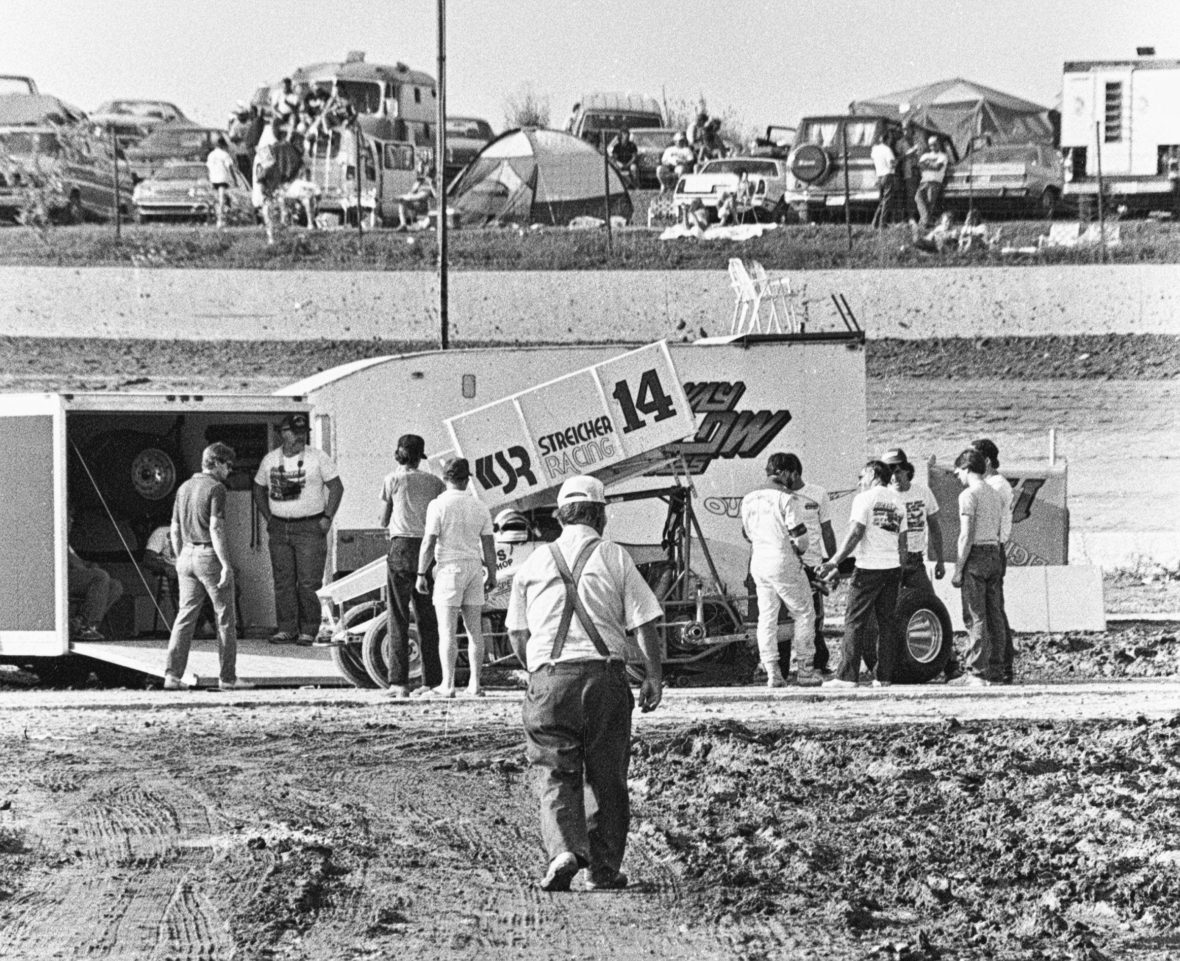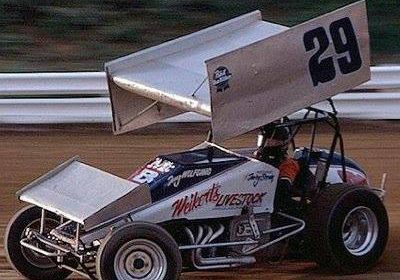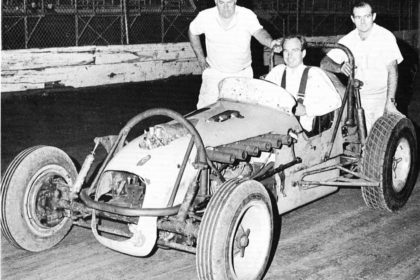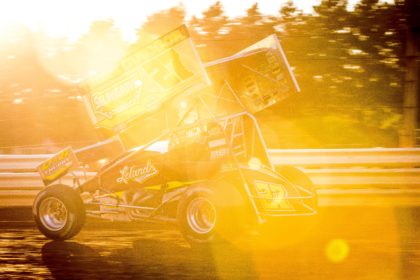Eldora and Earl Baltes. In many corners of the racing world, these names are synonymous, representing both risk and respect in every regard. A musician turned racetrack owner and promoter, the charismatic man with a flipped-up hat brim is widely regarded as one of the greatest promoters that racing has ever known. Earl’s story is one that reflects the American Dream, as he carved his empire of dirt into the corn fields of Ohio with only his wallet, hands and imagination to lean on.
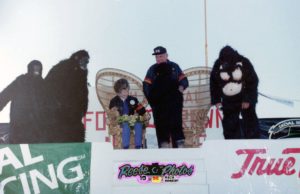
Earl & Bernice with their famous family of apes – 1995 – Larry Reese photo
Earl believed that putting everything on the line, both physically and financially, was a requirement to be a great promoter, and made a habit of doing so with stunts such as paying $1 million to win a late model race, (essentially) forcing Pancho Carter to marry two gorillas in victory lane before a USAC sprint car race – and then bringing them back to life in 1995, as well as voyaging to Daytona Beach to ask Big Bill France to cast his footprints in cement. Earl was never afraid of even the most bizarre and risky promotional schemes, no matter how outlandish or impossible they might have appeared.
Despite his successes at Eldora, his active imagination and sheer determination to succeed routinely led Earl to look beyond Eldora for promotional opportunities throughout the years. In fact, throughout his lifetime Earl owned or promoted races at the following speedways: Eldora, Powell Speedway, Salem, Millstream, Limaland, New Bremen, Mansfield, Dayton, Pleasant Hill, Volusia County (with Bert Emick) and Attica Raceway Park (with Gene Frankhart). At one point, he was the active promoter for Eldora, Dayton, Salem and New Bremen at the SAME TIME! To say that Earl possessed a unique sense of motivation would be a gross understatement. As a result, he never overlooked a potential opportunity, no matter how busy he was, including one that crept into the back of his mind in the early 1970’s when he began to consider, imagine and construct his largest undertaking since building Eldora less than 20 years prior.
Innovation in motor sports in the early 1970’s was rapid and radical. As the public watched racecars evolve from the large, bulky machines of the 1950’s and 60’s to the lightweight missiles of the 1970’s and beyond, the vision behind the ideal racetrack for the machines also began to shift. Earl Baltes’ ability to see these and other shifts in the racing world, and adapt his efforts to meet them, played a large role in his success, so it was only natural that he began to brainstorm ways in which he could become a part of the shifting paradigm as he watched the increasing popularity of larger speedways (most of which were one-mile or larger) sweep across the country in both USAC and NASCAR competition.
At the time, Earl owned several acres of farmland surrounding Eldora, including a large, relatively-level field in the southeast corner of the property. As Earl became increasingly intrigued by his ideas for a larger speedway of his own, he ordered measurements to be done on the property, which revealed that the necessary space was available for a track measuring one-mile in distance. At that point, Earl had an idea and an available plot of land, and so brainstorming for the exact size and shape of the speedway quickly began.
The larger speedways of Pocono, Milwaukee and Trenton were experiencing great success with their events in the early 1970’s, featuring several USAC, NASCAR and ARCA dates each year. Lucky for Earl, all three venues were within a day’s drive of Eldora, so naturally he sought out these speedways for inspiration as he brainstormed the layout for his own one-mile track. Earl especially took a liking to the shape and layout of Milwaukee, and after conversations with several superstars of the time, including Mario Andretti, Al Unser, A.J. Foyt and others, he learned that their favorite one-mile speedway was Milwaukee as well. Once he realized that his thoughts on the project reflected those of the competitors, Earl was all-in on the project. He returned home to Ohio, laid out the measurements for a track identical to Milwaukee on the vacant plot of land, and official plans for construction were drawn. True to his roots, Earl intended to build the speedway as a dirt track first, and then pave the surface at a later date with hopes of landing a NASCAR or ARCA race as a result. It was at this point that the Eldora Mile was no longer a far-fetched idea trapped in Earl’s imagination. It was time to make it happen.
With the help of a local contractor, Matt Schweiterman, heavy equipment was brought on site and construction for the Eldora Mile took place over the course of several months. Each day more and more dirt was moved to bring the track to life, and everything was going according to plan, at least from a physical sense. Progress on the physiological side was much more complex, however. Throughout the early phases of the project, Earl battled doubts in regards to the feasibility and potential profitability of the new speedway. The paradigm appeared to be shifting slightly in the racing world, and suddenly larger venues were struggling to attract the large crowds that were required to make the speedways profitable. Despite his anxieties with the matter, Earl decided to keep these thoughts to himself and allowed construction to continue, and in an attempt to ease his worries, ventured to Pocono to spectate an event at the speedway in the midst of his construction project. Rather than help to calm Earl’s nerves, his trip to Pocono further ignited his doubts instead, as the crowd for the event was marginally thin, and showed very few signs of promise. Once Earl returned home from Pocono, he decided to sit down and recalculate his anticipated total investment in the project one more time. What he saw were massive financial figures that suddenly looked much more frightening than they had a few months earlier. Especially considering the fact that by this time Pocono had determined that their event had operated at a loss, Ontario Speedway in California was rumored to be struggling financially, and the board members at the massive Michigan International Speedway (MIS) were considering selling the track at approximately 19 cents on the dollar for what they had invested in the speedway to pay off their debts. Despite all of the negative signs, Earl allowed the construction of the Eldora Mile to continue until a few short days before the second phase of construction was set to begin, which included the costly pouring of concrete for various structures around the speedway.
It was at this time that Schweiterman approached Earl in a panic, as he had outbid his company’s capabilities and been awarded more construction projects than he had the equipment to handle. Subsequently, Schweiterman asked Earl for permission to remove a few pieces of equipment from the site of the track so he could allocate them to his other projects. Earl’s immediate reaction was to decline his request, as the project for the speedway had been accepted and started prior to Schweiterman’s bidding of the other projects, as well as the fact that Earl needed the track completed as soon as possible so he could begin to generate income from his investment.
Despite declining Schweiterman’s request that morning, Earl continued to contemplate his contractor’s situation, as well as his own, throughout the remainder of the day. The evidence and bleak forecast for one-mile tracks once again crept into his mind, and in the end that was all he needed to reassure himself of his doubts on the project. Despite originally telling Schweiterman no, Earl eventually reconsidered and took Schweiterman’s request as a sign to pull the plug on the project before it was too late. And so, a few short hours after declining to surrender any of the equipment on his site, Earl informed his contractor that not only could he remove a few pieces of equipment, he could take all of it. Earl’s intuition, research and sinking gut feeling on the project had finally gotten the best of him, and Schweiterman’s request had pushed Earl over the edge. The project was immediately stopped, never to be started again. The Eldora Mile was shut down before it was ever completed, leaving only an outline of a racetrack as evidence of the massive project.
History is filled with, and in many ways based on, imagining different outcomes for various ‘what-if’ scenarios from the past. What if Earl hadn’t stopped the construction of the Eldora Mile? Would it have blossomed into another destination track just like Eldora? Or would it have failed miserably and destroyed the financial stability of not only itself, but Eldora Speedway and Earl Baltes as well? We will never know what may have happened, but it’s an intriguing footnote in the history of one of the world’s most famous dirt tracks nonetheless.
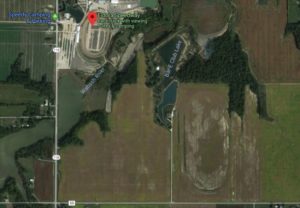 To add to the intrigue of this story, the outline of the speedway is still visible today! If you venture south on Rte 118 passed the speedway and hang a left onto McFeely Petry Road, you will come to a hill along the edge of an open field on your left just after the first driveway on your left. As seen in these aerial shots, if you walk to the top of the hill, you will find yourself standing at the Eldora Mile’s first turn.
To add to the intrigue of this story, the outline of the speedway is still visible today! If you venture south on Rte 118 passed the speedway and hang a left onto McFeely Petry Road, you will come to a hill along the edge of an open field on your left just after the first driveway on your left. As seen in these aerial shots, if you walk to the top of the hill, you will find yourself standing at the Eldora Mile’s first turn. 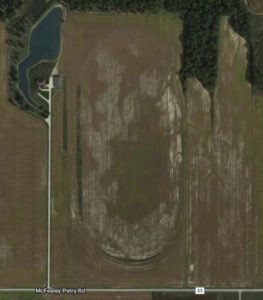 You will see Turns 3 and 4 to the North, and the sweeping corners of Turns 1 and 2 directly in front of you. For the most part, the earth moving that took place before the termination of construction has been left unchanged, as the land has been used for farming purposes ever since. The lack of disturbance of the ground provides us with a rare glimpse into a piece of history that has nearly fallen through the cracks of time. The next time you visit Eldora Speedway, take a few minutes and explore Earl’s greatest unfinished project, as the remains of the speedway serve as a great way to glimpse into the framework of the house that Earl almost built.
You will see Turns 3 and 4 to the North, and the sweeping corners of Turns 1 and 2 directly in front of you. For the most part, the earth moving that took place before the termination of construction has been left unchanged, as the land has been used for farming purposes ever since. The lack of disturbance of the ground provides us with a rare glimpse into a piece of history that has nearly fallen through the cracks of time. The next time you visit Eldora Speedway, take a few minutes and explore Earl’s greatest unfinished project, as the remains of the speedway serve as a great way to glimpse into the framework of the house that Earl almost built.
The title photo for this piece was taken by Ted Van Pelt. The book EARL! By Earl Baltes and Dave Argabright was used as a reference for several facts in this piece.
